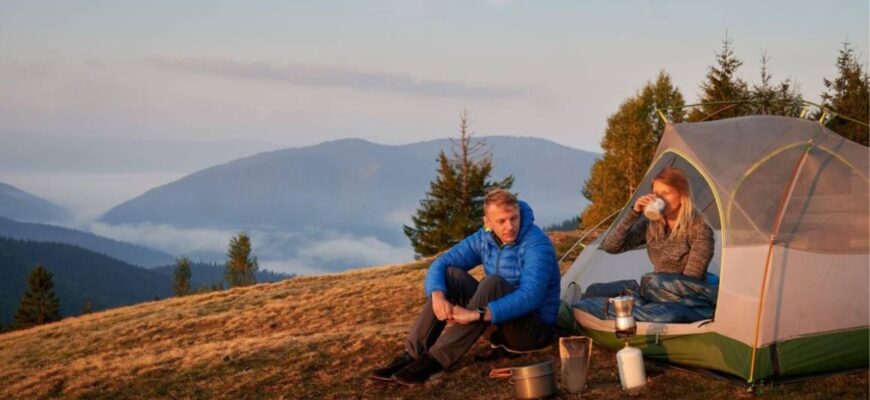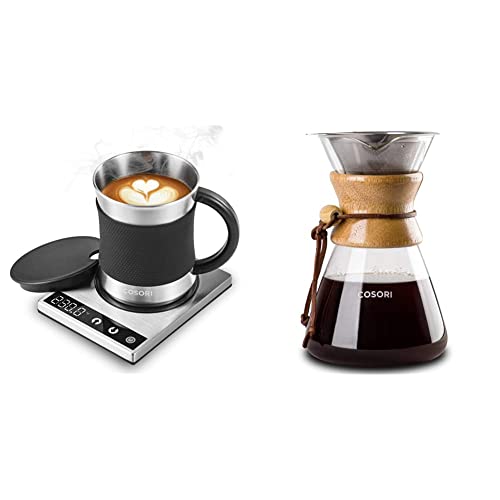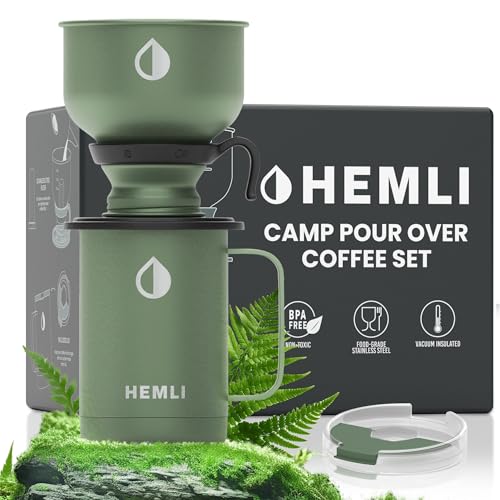- What Makes a Great Camping Pour Over Coffee Maker?
- Weight vs Performance Trade-offs
- Material Considerations
- Top 6 Best Pour Over Coffee Makers for Camping in 2025
- Complete Camping Pour Over Coffee Set: What You Need
- Essential Accessories
- Optional Upgrades
- How to Brew Perfect Pour Over Coffee While Camping
- Pre-Trip Preparation
- Field Brewing Techniques
- Troubleshooting Common Issues
- Pour Over vs Other Camping Coffee Methods
- Maintenance and Care Tips for Your Camping Pour Over
- Conclusion
- Frequently Asked Questions
- Can I use regular coffee filters for camping pour over makers?
- What’s the best grind size for pour over coffee while camping?
- How much does a good camping pour over coffee maker cost?
- Is pour over coffee worth it for backpacking vs instant coffee?
- What’s the lightest pour over option for ultralight backpacking?
- How do I heat water for pour over coffee while camping?
- Can I pre-grind coffee for camping trips or should I bring a grinder?
There’s something magical about that first cup of coffee while watching the sunrise over a mountain lake. But to make barista-quality pour over coffee in the wilderness, you need the right equipment. I tested dozens of camping pour-over coffee makers in all sorts of conditions, from the heat of the desert to the cold of the mountains. I found out which models are really good when you’re far from the nearest café.
The challenge? I’m looking for a coffee maker that’s light, strong and long-lasting for when I go camping. If it’s too heavy, it’ll weigh down your pack. If it’s too flimsy, it won’t survive the journey. This complete guide shows you the best options for 2025, as well as expert brewing techniques I’ve created over years of adventures in the backcountry.
What Makes a Great Camping Pour Over Coffee Maker?
Selecting the perfect camping pour over coffee set involves more than just picking the lightest option. Through extensive field testing, I’ve identified five critical factors that separate exceptional camping coffee makers from mediocre ones.
Weight and packability top the list. Every ounce matters when you’re carrying gear for miles. The best models weigh under 4 ounces while still maintaining structural integrity. Look for collapsible or nesting designs that maximize pack space efficiency.
Material quality directly impacts both durability and heat retention. Silicone offers extreme packability but can affect flavor if not food-grade. Titanium provides unmatched strength-to-weight ratio but comes at a premium price. Stainless steel strikes a balance, while BPA-free plastics work for ultralight enthusiasts willing to sacrifice some durability.
Wind resistance becomes crucial when brewing outdoors. Wide-base designs and lower centers of gravity prevent tipping. Some models include wind shields or integrate with camp stove systems for added stability.
Ease of cleaning matters more than you might expect. Limited water access in the backcountry means your coffee maker needs to rinse clean with minimal effort. Smooth surfaces without crevices work best.
Filter compatibility affects both convenience and ongoing costs. Universal compatibility with standard #2 or #4 filters means you can resupply anywhere. Some ultralight options use proprietary filters that may be harder to find.
Weight vs Performance Trade-offs
The eternal backpacking dilemma applies to coffee gear too. Ultralight camping pour over options under 2 ounces exist, but they often compromise on stability or capacity. Heavier models around 4-6 ounces typically brew better coffee and last longer.
For weekend warriors and car campers, a few extra ounces won’t matter. Choose performance over weight savings. Multi-day backpackers should prioritize ultralight options, accepting some brewing limitations. Consider your coffee commitment level – serious enthusiasts often happily carry extra weight for superior results.
Material Considerations
Each material brings distinct advantages to portable pour over coffee brewing. Titanium leads in durability and weight efficiency but transfers heat quickly, potentially affecting extraction. Its corrosion resistance makes it ideal for long-term use.
Stainless steel offers excellent heat stability and durability at a reasonable price point. The added weight works fine for most camping scenarios. Silicone revolutionized ultralight coffee making with collapsible designs weighing mere ounces. However, cheaper silicone can impart flavors.
BPA-free plastics provide the lightest options but may crack in freezing temperatures. They work well for occasional use in moderate conditions. Avoid them for winter camping or heavy use.
Top 6 Best Pour Over Coffee Makers for Camping in 2025
After extensive testing in various conditions, these seven models represent the best camping pour over coffee maker options available. Each excels in specific scenarios, from ultralight backpacking to base camp comfort.
Complete Camping Pour Over Coffee Set: What You Need
A quality camping pour over coffee set extends beyond just the dripper. Building a complete kit ensures consistently excellent coffee regardless of conditions. Here’s what experienced outdoor coffee enthusiasts actually carry.
Essential components include your pour over dripper, filters, a reliable grinder, and proper storage containers. A gooseneck kettle improves pouring precision, though many camping models work adequately. Don’t forget a small scale – consistent ratios matter even in the wilderness.
Coffee storage requires airtight containers that protect beans from moisture and crushing. Vacuum-sealed bags work for short trips. Hard-sided containers prevent damage in packed conditions. Pre-portioned daily amounts save time and ensure freshness.
Water heating options range from ultralight canister stoves to traditional campfires. Jet boil systems excel at rapid heating but lack temperature control. Traditional camp stoves offer better heat management for optimal 195-205°F brewing temperatures.
Essential Accessories
Your camping coffee brewing setup needs several key accessories for consistent results. A hand grinder designed for travel provides fresh grounds without electricity. Look for models with ceramic burrs that resist corrosion and maintain sharpness.
Collapsible scales weighing under 3 ounces help maintain proper coffee-to-water ratios. Waterproof models survive inevitable spills. Some integrate timers for monitoring extraction.
Insulated mugs keep coffee hot in cold conditions while preventing burns. Double-wall designs work best. Lid compatibility matters for windy conditions.
Optional Upgrades
Dedicated enthusiasts enhance their outdoor pour over experience with specialized gear. Portable water filters ensure clean brewing water from natural sources. Ultralight models add mere ounces while dramatically improving coffee quality in backcountry settings.
Temperature-controlled kettles running on rechargeable batteries maintain precise water temperatures. They’re heavier but deliver café-quality results. Collapsible drip stands stabilize your setup on uneven ground while providing proper height for extraction.
How to Brew Perfect Pour Over Coffee While Camping
Mastering pour over coffee camping techniques requires adapting traditional methods to outdoor challenges. Wind, uneven surfaces, and limited resources demand modified approaches that still deliver exceptional results.
Start with proper grind consistency. Medium-fine works best for most camping pour overs, slightly coarser than indoor brewing to account for temperature variations. Grinding fresh each morning makes a noticeable difference – pre-ground coffee loses aromatic compounds quickly in outdoor conditions.
Water temperature becomes trickier without precise controls. After boiling, let water rest 30-45 seconds for optimal 195-205°F extraction. Cold environments require shorter rest times. Use the wrist test – water should feel hot but not scalding.
Pouring technique adapts to conditions. In wind, pour closer to the coffee bed with a steadier stream. Start with a 30-second bloom using twice the coffee weight in water. Continue with slow, circular pours maintaining consistent water levels.
Pre-Trip Preparation
Smart camping coffee preparation begins at home. Pre-measure coffee portions in waterproof bags labeled by day. Include 20% extra for spillage or sharing. Test your complete setup in the backyard, timing your routine to streamline morning brewing.
Season new equipment before trips. Brew several batches through new drippers to eliminate manufacturing residues. Practice your pouring technique with camping gear – it handles differently than home equipment.
Field Brewing Techniques
Successful backcountry pour over brewing requires environmental awareness. Shield from wind using your body, pack, or natural features. Rocky outcrops and fallen logs provide excellent windbreaks. Some campers dig shallow depressions for extra stability.
Level your setup on uneven ground using flat rocks or sticks. Even slight angles affect extraction uniformity. In extreme cases, hold the dripper manually for better control. Conserve water by perfecting your technique to minimize waste.
Troubleshooting Common Issues
Bitter coffee usually indicates over-extraction from too-fine grounds or excessive brew time. Coarsen your grind or pour faster. Sour coffee suggests under-extraction – try finer grounds or slower pouring.
Uneven extraction appears as both bitter and sour notes. Ensure level setup and consistent pouring patterns. Temperature issues affect all aspects – use windscreens and insulated containers to maintain heat throughout brewing.
Pour Over vs Other Camping Coffee Methods
Understanding how pour over coffee makers for camping compare to alternatives helps choose the right method for each adventure. Each brewing style offers distinct advantages depending on your priorities.
French press delivers full-bodied coffee with minimal technique requirements. However, cleaning becomes challenging with limited water. Glass models break easily while metal versions add significant weight. Best for car camping or short trips with reliable water access.
AeroPress excels at durability and versatility, brewing everything from espresso-style shots to traditional coffee. The plastic construction survives abuse. Downsides include proprietary filters and limited capacity for groups.
Instant coffee has improved dramatically, with specialty roasters offering impressive options. Nothing beats the convenience and weight savings. Yet even premium instant can’t match fresh-brewed pour over quality.
Cowboy coffee requires only a pot and heat source. The rustic method works anywhere but produces inconsistent results with significant sediment. It’s a backup option rather than a primary choice.
| Method | Weight | Quality | Cleanup | Skill Required | Group Serving |
|---|---|---|---|---|---|
| Pour Over | Light | Excellent | Easy | Moderate | Individual |
| French Press | Heavy | Good | Difficult | Low | Groups |
| AeroPress | Light | Very Good | Easy | Low | Individual |
| Instant | Ultralight | Fair | None | None | Flexible |
| Cowboy | Moderate | Variable | Moderate | Low | Groups |
Maintenance and Care Tips for Your Camping Pour Over
Proper maintenance extends your camping pour over coffee maker’s lifespan while ensuring consistently great coffee. Field care differs from home maintenance due to resource limitations.
Daily cleaning prevents oil buildup that creates bitter flavors. Rinse immediately after use when possible. Without adequate water, wipe clean with biodegradable camp towels. Pack used filters out – never bury or burn them.
Deep cleaning between trips removes accumulated oils and mineral deposits. Soak in hot water with mild dish soap, scrubbing gently with soft brushes. Avoid abrasives that damage surfaces. Silicone tolerates dishwashers; check manufacturer guidelines for other materials.
Storage matters more than expected. Ensure complete drying before packing to prevent mold. Store in breathable bags rather than airtight containers. Separate metal components from other gear to prevent scratching.
Material-specific care varies significantly. Titanium requires minimal maintenance beyond basic cleaning. Stainless steel may develop harmless discoloration from heat. Silicone needs occasional deep cleaning to prevent flavor retention. Plastic components require gentle handling and temperature awareness.
Conclusion
Finding the best pour over coffee maker for camping transforms your outdoor coffee experience from mere caffeine delivery to a cherished morning ritual. The models reviewed here represent the pinnacle of portable brewing technology for 2025, each excelling in specific scenarios.
Remember that the perfect camping coffee setup balances your personal priorities. Ultralight backpackers will sacrifice some quality for weight savings, while car campers can indulge in heavier, higher-performing equipment. Start with one of our recommended models matching your typical adventures.
Your ideal camping pour over coffee set evolves with experience. Begin simple, then upgrade components as you identify specific needs. Most importantly, don’t let gear obsession overshadow the simple pleasure of enjoying exceptional coffee in extraordinary places.
Ready to elevate your camping coffee game? Check current prices on our top picks and start planning your next caffeinated adventure.
Frequently Asked Questions
Can I use regular coffee filters for camping pour over makers?
Most camping pour over coffee makers accept standard #2 or #4 filters available at any grocery store. This universal compatibility proves invaluable for resupply during extended trips. Some ultralight models use proprietary filters for weight savings – stock up before heading out. In emergencies, paper towels or clean cloth work as makeshift filters, though they affect extraction rates.
What’s the best grind size for pour over coffee while camping?
Medium-fine grind works best for pour over coffee camping, slightly coarser than typical home brewing. This compensates for temperature variations and less precise pouring outdoors. The grounds should resemble coarse sand, not powder. Adjust finer in cold conditions or coarser in heat. Hand grinders with marked settings eliminate guesswork.
How much does a good camping pour over coffee maker cost?
Quality camping pour over options range from $15 for basic plastic models to $100+ for premium titanium designs. The sweet spot sits around $25-45, delivering durability and performance without breaking budgets. Factor in long-term value – a $60 titanium dripper lasting decades beats replacing cheap alternatives annually.
Is pour over coffee worth it for backpacking vs instant coffee?
For true coffee enthusiasts, portable pour over coffee justifies the extra weight and effort. The quality difference remains substantial, especially with modern ultralight options under 2 ounces. However, instant coffee technology has improved dramatically. Many backpackers carry both – pour over for leisurely mornings and instant for quick trail breaks.
What’s the lightest pour over option for ultralight backpacking?
The lightest ultralight camping pour over options weigh under 1 ounce using innovative silicone designs or minimal wire frames. Some Japanese-designed cloth filters weigh mere grams. However, extreme weight savings often compromise stability and durability. Most ultralight enthusiasts find 2-3 ounce options provide the best performance-to-weight ratio.
How do I heat water for pour over coffee while camping?
Efficient water heating makes or breaks your camping coffee brewing routine. Canister stoves with wind protection boil water fastest, typically under 3 minutes. Alcohol stoves work well in moderate conditions but struggle in wind or cold. Traditional campfires provide ambiance but lack temperature control. Jetboil-style systems excel at speed but may overheat water – let it cool before brewing.
Can I pre-grind coffee for camping trips or should I bring a grinder?
While pre-grinding saves weight and time, fresh-ground coffee dramatically improves your camping pour over coffee experience. Coffee begins losing aromatic compounds within minutes of grinding. For weekend trips, pre-grinding works adequately if stored in airtight containers. Longer adventures benefit from compact hand grinders weighing 8-12 ounces. The flavor difference justifies the extra weight for most enthusiasts.







